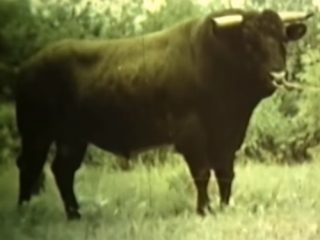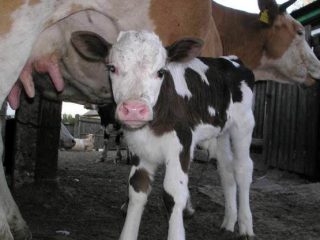Content
- 1 What is leukemia in cattle
- 2 The causative agent of leukemia in cattle
- 3 How is bovine leukemia transmitted?
- 4 Symptoms of leukemia in cattle
- 5 Stages of bovine leukemia
- 6 Methods for the diagnosis of cattle leukemia
- 7 Treatment of leukemia in cattle
- 8 Instructions for the prevention of leukemia in cattle
- 9 Pathological changes in cattle leukemia
- 10 Conclusion
Bovine viral leukemia has become widespread not only in Russia, but also in Europe, Great Britain, and South Africa. Leukemia is causing irreparable damage to the cattle industries. This is due to increased culling of the herd, waste disposal, treatment, and other activities. The more intensive development of the disease occurs in the dairy sector.
What is leukemia in cattle
The causative agent of the disease is an infectious pathology containing an oncogenic virus. It is similar to leukemia in other animal breeds. There is another option that sheep and goats are tolerant to. Leukemia is associated with malignant proliferation of hematopoietic tissue cells and is of a tumor nature. The virus can be latent for a long time and not manifest itself. Rapid development begins with a decrease in immunity. In the course of the disease, the immune system is completely destroyed, so the animal is susceptible to repeated leukemia even after the cure. Lack of immunity leads to an increase in the duration of other diseases.
The causative agent of leukemia in cattle
The causative agent is a specific leukemia virus. It is extremely unstable in the external environment and dies at 76 degrees in 16 seconds. Boiling water kills him instantly. It is destroyed by various disinfecting compounds:
- 2-3% sodium hydroxide solution;
- 3% formaldehyde;
- 2% chlorine solution.
Also deactivated under ultraviolet light in 30 minutes. In direct sunlight - 4 hours. Sensitive to various kinds of solvents - acetone, ether, chloroform.
Bovine leukemia virus has a spherical structure, up to 90 nm in size. Consists of a cubic core surrounded by a lipoprotein sheath. Contains a genome with two helical RNA molecules.
Antigenically, bovine leukemia viruses are related but distinct from retroviruses. Based on similarities and differences, it can be attributed to a special group - type E.
How is bovine leukemia transmitted?
The main cause of pathogenesis in cattle leukemia is a disdainful attitude towards the livestock, lack of disinfection of premises, ignoring of preventive measures.
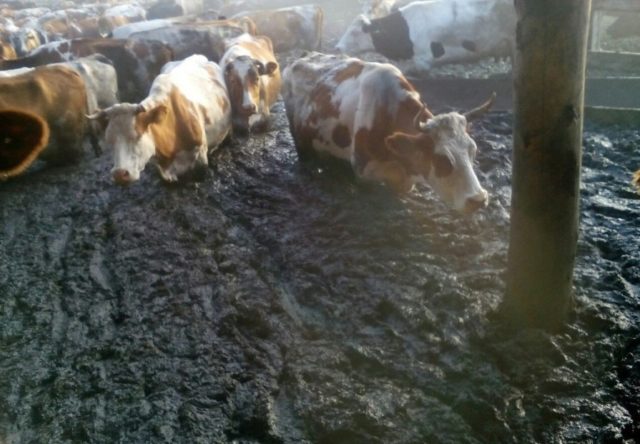
Unsanitary conditions in the barn
Transmitted:
- With direct contact between animals through biological fluids - blood, milk, semen. Calves are already born infected or acquire the disease through breast milk. In the herd, they can become infected even in the absence of an inseminating bull. Animals jump on top of each other, damaging the skin. If one animal is infected, it can transmit the virus through lesions.
- Through the bites of blood-sucking insects. Any blood feeding is dangerous. No methods of struggle have been found.
- Through non-sterile veterinary instruments during mass examinations, vaccinations. Symptoms do not appear immediately. During this time, most of the herd may become infected.
There are 2 forms of leukemia - sporadic and enzootic. The first is very rare and develops only in young animals. The second has a latent period of more than 3 months. Affects adults.
Symptoms of leukemia in cattle
The initial stages of the disease are asymptomatic.Health disorders are noted only in the later stages. After a change in the composition of the blood, the signs become more noticeable:
- Weakness of the animal.
- Increased breathing.
- Weight loss.
- Problems with the gastrointestinal tract.
- Swelling of the dewlap, udder, abdomen.
- Lameness in the hind legs.
- Swollen lymph nodes.
- Visible swelling.
- Ophthalmic eyes. It appears rarely.
Depletion and weakness results from poor digestibility of nutrients from feed. Milk dispensing decreases.
Stages of bovine leukemia
Any cattle is susceptible to leukemia. There are 3 stages:
- Incubation. The latent period is up to 3 months. It starts from the moment of the virus attack. Outwardly, it does not manifest itself at all. In cows with strong immunity, it may take longer.
- Hematological. It is characterized by a change in blood composition with a rapid increase in white blood cells - leukocytes. White blood is analyzed by composition. At this moment, the first disturbances in the work of the gastrointestinal tract begin.
- The development of a tumor in the hematopoietic organs. This can happen 4-7 years after infection.
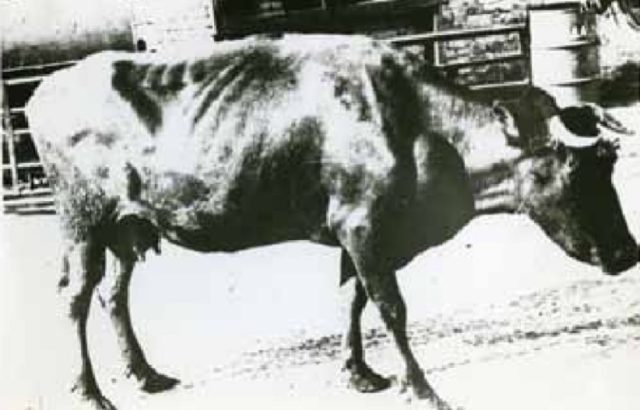
Enlargement of the prescapular lymph node in bovine leukemia
The early stages of the disease can be found in milk tests. Therefore, it is extremely important to take it to the laboratory periodically. This will help isolate infected individuals and avoid mortality.
Methods for the diagnosis of cattle leukemia
The first case of leukemia with white blood cells in an enlarged spleen was described in 1858. Since the end of the 19th century, for almost 100 years, scientists have been trying to find the causative agent of the bovine leukemia virus. It was only opened in 1969. Leukemia came to our country with the import of pedigree cattle.
Several diagnostic methods are known - primary, serological, differential. The primary method is used on farms. The basis for it is the pathological examination of fallen animals, blood tests, the study of epizootological and serological data. Taking a histological sample is mandatory.
Signs of leukemia in the initial diagnosis:
- Clinical.
- Hematological changes - an increased number of leukocytes and atypical cells of the hematopoietic organs.
- Pathological changes in the organs of dead cattle.
- A positive result of histological studies.
In bovine leukemia, laboratory diagnosis is the most reliable way to determine the disease.
Leukocytes are counted in a Goryaev chamber or genus with a microscope. Leukocytes and lymphocytes are compared with the data in the "leukemic key" table. Based on the number of bodies and blood morphology, a conclusion is made about the disease - a healthy animal, falls into a risk group or is already sick.
Serological studies are used to identify antibodies to the bovine leukemia virus antigen. Appear 2 months after infection of the patient - much earlier than noticeable hematological changes. Then they persist throughout life. The immunodiffusion reaction (RID) is the main research method in Russia and other countries. Animals that test positive for RID are considered infected. Such clinical results or blood tests immediately translate cattle into the category of sick.
Differential diagnosis of bovine leukemia defines the disease based on a number of chronic infectious and non-infectious diseases.
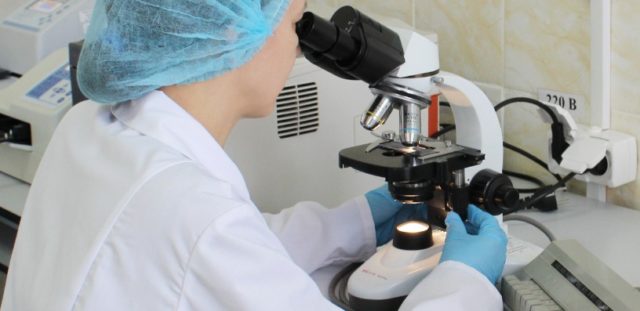
Diagnostics of the cattle leukemia
These are tuberculosis, actinomyosis, brucellosis, hepatitis, cirrhosis, nephritis and other diseases of the liver, lungs, bones. These diseases are accompanied by leukemia-like changes - leukemoid reactions.
Treatment of leukemia in cattle
At the moment, no effective treatment option has been found.Attempts were made to eliminate bovine leukemia with a vaccine, but they were unsuccessful. The main therapy is associated with culling and slaughtering cows. It is recommended to slaughter the animal at an early stage of the disease, so as not to torment and not lose profit on treatment. Milk from leukemic cows is prohibited by law. The same ban was imposed on the consumption of meat from sick animals. Milk from virus carriers is subject to mandatory pasteurization. Then they are disinfected and used without restrictions.
According to veterinary rules, in case of cattle leukemia, dairy farms are forced to slaughter the livestock completely. Treatment takes a long time and can take years.
Farms with a small number of sick - up to 10% of the livestock, separate leukemic cows and put them for slaughter. Serological tests are carried out every 2 months.
When the number of cases is more than 30%, not only serological studies are carried out, but also hematological ones after 6 months. Livestock are divided into groups that have successfully passed research and virus carriers. The sick are separated for slaughter.
Instructions for the prevention of leukemia in cattle
Farms with this disease are brought under control and declared dysfunctional. According to the rules for combating bovine leukemia, a number of restrictions are imposed on them to reduce the spread of infection. Quarantine measures do not allow:
- Driving livestock within settlements without the permission of a veterinarian.
- Free mating of cows with bulls-producers.
- The use of contaminated tools in the treatment of animals and premises.
- Joint maintenance of healthy and sick.
- Free import and export of animals.
Measures for cattle leukemia presuppose quarantine holding of all newly arrived livestock. Sale of meat and dairy products is carried out only with the permission of the veterinary station.
During the quarantine period, the premises for keeping livestock and animal care items are regularly disinfected.
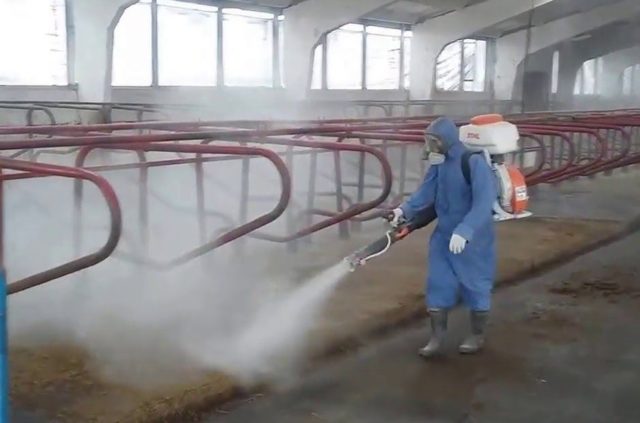
Disinfection of premises with leukemia
All waste products of cattle are disposed of.
To restore the livestock, replacement young growth is raised. He is kept in other premises, grazed on separate pastures. Upon reaching the age of 6 months, serological tests are performed, then repeated every six months. According to the instructions for cattle leukemia, infected young animals are separated and fattened away from healthy ones. Then they are slaughtered.
Pathological changes in cattle leukemia
An autopsy of dead animals is carried out periodically to study the course of the disease, the causes of death, the effect on individual organs and systems as a whole. Bovine leukemia leads to the elimination of the diseased livestock. An autopsy shows at different stages of the development of leukemia diffuse or focal infiltration into different parts of the body:
- organs of hematopoiesis;
- serous integuments;
- digestive system;
- heart;
- lungs;
- uterus.
The main forms of the disease are leukemia and reticulosis. Changes in leukemia:
- greatly enlarged spleen - up to 1 m;
- an increase in follicles;
- rupture of capsules with hemorrhage into the peritoneum;
- an increase in the supra-udder lymph nodes in the tumor stage up to 10 * 20 cm;
- the smooth capsule is easily removed, the pattern of the tissue of the lymph nodes is smoothed;
- liver, heart, kidneys germinate with diffuse or focal neoplasms from gray-white to gray-pink;
- pathology of other organs manifests itself in the later stages of the disease.
Changes with reticulosis:
- uneven increase in lymph nodes;
- the capsule is not smooth, but rough;
- fusion of the capsule with adjoining organs and tissues;
- tumors of various sizes - from a pea to 30 kg;
- the color of the tumor is gray-white;
- dense tumor covered with foci of necrosis and hemorrhage;
- dystrophic changes are noticeable in the liver, spleen, endocrine glands, brain;
- possible metastases to the abomasum, heart, and other organs.
Conclusion
The bacteria that cause bovine leukemia cannot tolerate heat treatment. But infection in the early stages is asymptomatic. If diagnostics are carried out on time, young animals, infected animals are isolated, antiseptic treatment is carried out, the sick are slaughtered, the likelihood of farm recovery from cattle leukemia will be higher. It is better to stop the infected cattle in time than to completely lose the livestock.
